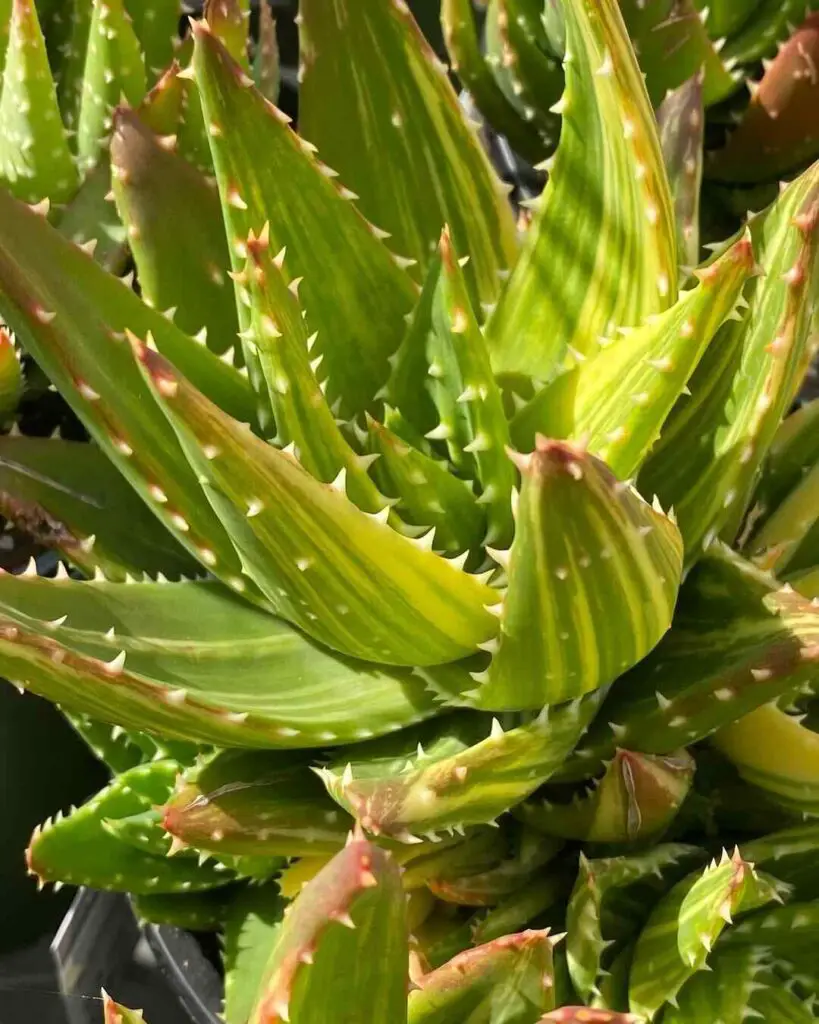Aloe Vera plants are known for their numerous benefits, from soothing sunburns to improving air quality. If you’re looking to grow more of these resilient plants, propagating Aloe Veras in water is an easy and effective method. This guide will walk you through the process step-by-step, ensuring you can successfully grow your Aloe Vera collection.
By following simple instructions, you can propagate Aloe Vera without the need for soil. Water propagation is a low-maintenance technique, making it perfect for beginners and seasoned gardeners alike. Let’s dive into how you can start your Aloe Vera propagation in water!

Preparing Your Aloe Vera Cutting for Water Propagation
Properly preparing your Aloe Vera cutting is a crucial step to ensure it roots successfully in water. Follow these steps to get your cutting ready for propagation:
- Let the cutting dry: After cutting the Aloe Vera leaf, allow it to air dry for at least 24 to 48 hours. This process helps the cut end callous over, reducing the risk of rot when placed in water.
- Trim excess tissue: If the cutting has any excess tissue near the base, trim it off. This makes the cutting more stable and ensures that only healthy tissue is submerged in water.
- Clean the cutting: Gently rinse the cutting with water to remove any dirt or debris. Be cautious not to damage the cut area or disturb the drying process.
Once your cutting is dry and clean, it’s ready to be placed in water for the rooting process. Make sure the cut end is submerged in water, but the rest of the leaf should remain above the surface to prevent rot.
Setting Up Your Water Propagation Station
Creating the right environment for your Aloe Vera cutting is essential for successful rooting in water. Follow these steps to set up an ideal propagation station:
- Choose a clear container: Use a glass or transparent plastic container to place your Aloe Vera cutting. A clear container allows you to monitor root growth and water levels easily.
- Fill with clean water: Fill the container with fresh, non-chlorinated water. Distilled or filtered water is ideal to avoid any chemicals that might harm the cutting.
- Ensure proper water level: The cut end of the Aloe Vera leaf should be submerged in the water, but the rest of the leaf should stay above the surface to prevent rot.
Place the container in a warm, bright spot, but out of direct sunlight to prevent overheating. A location with indirect light is perfect for encouraging root growth without stressing the cutting. Keep the water level consistent and change it every few days to prevent stagnation.
Creating the Best Environment for Rooting
To encourage your Aloe Vera cutting to root successfully, it’s important to create the right environment. Here’s how to ensure optimal conditions for rooting:
- Provide indirect sunlight: Place the container in a location that gets bright, indirect sunlight. Aloe Vera thrives in light, but too much direct sun can cause the cutting to dry out or overheat.
- Maintain a warm temperature: Aloe Vera cuttings root best in temperatures between 65°F and 75°F (18°C to 24°C). Avoid placing the cutting in a cold or drafty area, as this can slow down the rooting process.
- Monitor water levels: Keep the water level consistent, ensuring the cut end remains submerged. Check the water every few days, topping it off as needed to prevent the cutting from drying out.
To further enhance the rooting process, you can cover the container with a clear plastic lid or wrap to create a mini greenhouse effect. This will help maintain humidity and encourage faster root growth. Be sure to remove the cover periodically to allow fresh air circulation.
Patience: Key to Successful Rooting
Rooting an Aloe Vera cutting in water takes time, and patience is essential for success. Here’s why patience is the secret ingredient in the process:
- Root development takes time: Aloe Vera roots typically take 2 to 3 weeks to start developing, although some cuttings may take longer. It’s important not to rush the process. Be patient and resist the urge to check the cutting constantly.
- Slow and steady growth: Aloe Vera roots grow gradually, so don’t be discouraged if you don’t see immediate results. The cutting may show small signs of growth, like tiny white roots, which means it’s working!
- Avoid over-manipulating the cutting: Frequently moving or touching the cutting can disrupt the rooting process. Once placed in water, let it stay undisturbed, as too much interference can hinder root growth.
Keep in mind that each Aloe Vera cutting is unique, and some may take more time than others to establish roots. With consistent care, your cutting will eventually grow into a healthy, new Aloe Vera plant.
Transferring Your Aloe Vera Cutting to Soil
Once your Aloe Vera cutting has developed a strong root system in water, it’s time to transfer it to soil for continued growth. Here’s how to make the transition smooth and successful:
- Choose the right soil: Aloe Vera plants prefer well-draining soil. Use a cactus or succulent mix, or make your own by adding sand or perlite to regular potting soil. Good drainage is key to preventing root rot.
- Prepare the pot: Select a pot with drainage holes to allow excess water to escape. This helps maintain healthy root conditions. Fill the pot halfway with the soil mixture before planting.
- Transplant with care: Gently remove the Aloe Vera cutting from the water, being cautious not to damage the roots. Place the cutting in the center of the pot and carefully cover the roots with soil, leaving the base of the leaf exposed above the soil surface.
After transferring, water the plant lightly to settle the soil, but avoid overwatering. Place the pot in a location with bright, indirect sunlight. Your Aloe Vera cutting will adapt to its new home and continue to thrive!
Caring for Your New Aloe Vera Plant
Proper care is essential to help your new Aloe Vera thrive after transferring it to soil. Here’s how to keep your plant healthy and growing:
- Water sparingly: Aloe Vera is drought-tolerant, so overwatering can lead to root rot. Water the plant only when the soil is completely dry, typically every 2-3 weeks. Ensure the pot has good drainage to allow excess water to escape.
- Provide ample sunlight: Aloe Vera loves sunlight, but it thrives best in bright, indirect light. Avoid placing it in direct sunlight for prolonged periods, as this can cause the leaves to scorch. A spot near a window with plenty of natural light is ideal.
- Fertilize occasionally: Aloe Vera doesn’t require frequent fertilization. Feed your plant with a diluted, balanced fertilizer during the growing season (spring and summer) every 4-6 weeks. Avoid fertilizing in the winter when the plant is dormant.
In addition to these care tips, check for pests occasionally, such as aphids or mealybugs, and keep the plant in a well-ventilated space. With the right care, your new Aloe Vera will grow strong and healthy, providing you with years of beauty and benefits!
Common Issues and Troubleshooting for Aloe Vera Plants
Even with proper care, Aloe Vera plants can sometimes face challenges. Here are some common issues and how to troubleshoot them:
- Yellowing leaves: This often indicates overwatering. Aloe Vera is sensitive to excessive moisture, which can cause root rot. Ensure the soil is well-draining and allow it to dry out completely between waterings. If the leaves continue to yellow, check for root rot by gently removing the plant from its pot and inspecting the roots.
- Brown tips: Brown tips on Aloe Vera leaves can be caused by underwatering, low humidity, or exposure to direct sunlight. Adjust your watering schedule to ensure the soil stays dry but not too parched. If the plant is in direct sunlight, move it to a spot with indirect light.
- Stunted growth: If your Aloe Vera is not growing as expected, it may be a sign that it’s root-bound or lacking nutrients. Repot the plant into a larger pot with fresh, well-draining soil and fertilize lightly during the growing season to encourage growth.
- Pests: Aloe Vera can attract pests like aphids, mealybugs, or scale. Check the plant regularly for signs of pests. If detected, gently wipe the leaves with a damp cloth or use insecticidal soap to remove the pests. Keep the plant in a well-ventilated area to discourage infestations.
By addressing these issues promptly and making necessary adjustments, you can ensure your Aloe Vera thrives in the long run.
Decorating Your Home with Aloe Vera Plants
Aloe Vera plants not only offer health benefits but also make beautiful, low-maintenance additions to your home decor. Here are some creative ways to incorporate Aloe Veras into your living space:
- Place Aloe Vera in stylish pots: Choose pots that complement your home’s aesthetic. Sleek, modern planters work well in contemporary spaces, while rustic terracotta pots add charm to a more natural or earthy design. You can even try DIY potting projects to personalize the look.
- Display in sunny spots: Aloe Vera plants thrive in bright, indirect light. Place them on windowsills, countertops, or shelves where they can receive plenty of natural light, enhancing both their health and the look of the space.
- Create a green corner: Designate a corner of your home to house multiple Aloe Vera plants along with other succulents. This will create a vibrant, calming space filled with greenery that can serve as a focal point in any room.
Aloe Veras are also perfect for minimalist decor due to their clean lines and simple beauty. With their striking appearance and ease of care, they can brighten up any room, adding a touch of nature without requiring too much attention.
Benefits of Propagating Aloe Veras in Water
Propagating Aloe Vera in water offers several advantages that make it an appealing method for both beginner and experienced gardeners. Here’s why water propagation is a great option:
- Easy to monitor root growth: One of the key benefits of water propagation is the ability to observe root development. With a clear container, you can see the roots grow, ensuring that the cutting is healthy and making progress.
- Minimal effort required: Water propagation requires little maintenance. Unlike soil propagation, there’s no need to worry about soil moisture or soil quality. Simply ensure the cutting is submerged in clean water and let nature take its course.
- Reduced risk of pests and diseases: When propagating in water, the chances of pests and soil-borne diseases affecting the cutting are significantly reduced. Without soil to harbor pests, your Aloe Vera cutting is less likely to encounter common plant problems.
Additionally, water propagation is a sustainable and cost-effective method for growing new Aloe Veras, making it an ideal choice for those looking to expand their plant collection or share Aloe Vera plants with friends and family.
Final Thoughts
Propagating Aloe Vera in water is an easy and rewarding method to expand your plant collection. With patience and the right care, you’ll enjoy watching your Aloe Vera thrive and grow. Whether you’re starting with a single cutting or creating a collection, this process provides a simple yet effective way to nurture new plants in your home.

I’m Shofi, a passionate gardener and blogger. I have 10+ years of experience in gardening and hold certifications in horticulture and garden design. I share my knowledge and skills through my garden blog to inspire and educate others on the joys of gardening. I try to provide valuable information and create a community for gardeners of all levels to connect and learn. My ultimate goal is to inspire others to start their own gardens and connect with nature.

